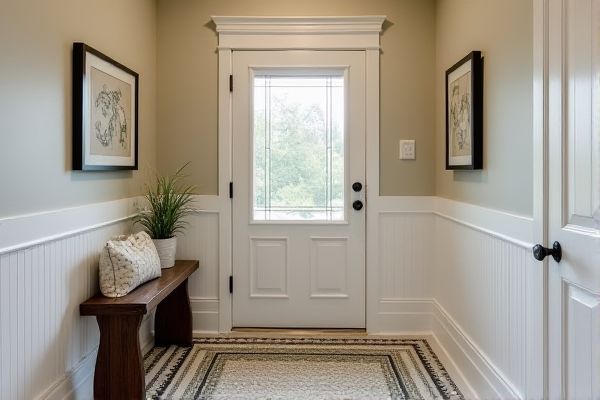
Tile wainscoting in a mudroom offers superior durability and moisture resistance, making it ideal for high-traffic or wet areas, while wood wainscoting provides a warm, classic aesthetic and can be customized with paint or stain for a personalized touch. Explore the rest of this article to discover which wainscoting option best suits your mudroom's style and functionality.
Table of Comparison
| Feature | Tile Wainscoting | Wood Wainscoting |
|---|---|---|
| Durability | Highly durable, water-resistant, ideal for mudrooms | Moderately durable, may warp or rot if exposed to moisture |
| Maintenance | Easy to clean, resistant to stains and scratches | Requires regular sealing or painting, prone to dents |
| Appearance | Modern, sleek, available in various colors and patterns | Classic, warm, natural wood grain enhances mudroom aesthetics |
| Installation | More complex, requires grout and precise placement | Easier, can be installed by DIYers with basic carpentry skills |
| Cost | Higher upfront cost due to materials and labor | Generally lower cost, depending on wood species |
| Moisture Resistance | Excellent, ideal for high-humidity mudrooms | Poor to moderate; needs protective finish |
| Longevity | Long-lasting when properly maintained | Can last long with maintenance but vulnerable to water damage |
Introduction to Mudroom Wainscoting
Mudroom wainscoting enhances both durability and style, with tile offering water resistance and easy cleaning, ideal for wet or muddy environments. Wood wainscoting provides warmth and traditional charm, adding natural texture and insulation to your space. Choosing between tile and wood depends on your mudroom's functionality and aesthetic preferences to best suit your lifestyle.
Key Differences: Tile vs. Wood Wainscoting
Tile wainscoting in a mudroom offers superior durability and water resistance, making it ideal for high-moisture areas prone to dirt and mud. Wood wainscoting provides a warmer, more traditional aesthetic but requires regular maintenance to prevent damage from moisture and wear. Tile allows for easier cleaning and a wider variety of design options, while wood offers customization through paint or stain for a cozy, classic look.
Durability Comparison: Tile and Wood in Mudrooms
Tile wainscoting in mudrooms offers superior durability due to its resistance to moisture, stains, and scratches, making it ideal for high-traffic and wet environments. Wood wainscoting, while aesthetically warm and customizable, is more susceptible to water damage, warping, and dents without proper sealing and maintenance. Choosing tile enhances longevity and ease of cleaning, whereas wood requires regular upkeep to maintain structural integrity and appearance.
Moisture Resistance: Which Wainscoting Performs Better?
Tile wainscoting outperforms wood wainscoting in moisture resistance, making it the superior choice for mudrooms prone to dampness. Unlike wood, tile resists warping, mold, and water damage, ensuring longevity and easy maintenance. Choosing tile wainscoting protects your walls from moisture-related issues, preserving both functionality and aesthetic appeal.
Aesthetic Appeal: Style Options for Tile and Wood
Tile wainscoting offers a wide range of style options, from sleek subway tiles to intricate mosaic patterns, providing a modern and durable look ideal for mudrooms. Wood wainscoting brings warmth and classic charm with various panel designs such as beadboard, raised panels, or shiplap, allowing for a traditional or rustic aesthetic. Your choice depends on whether you prefer the easy-to-clean, water-resistant surface of tile or the timeless, textured appeal of wood to complement your mudroom's overall style.
Maintenance Requirements: Tile vs. Wood Wainscoting
Tile wainscoting in a mudroom offers superior durability and low maintenance, requiring only regular wiping to prevent dirt buildup and occasional grout sealing to maintain water resistance. Wood wainscoting demands more upkeep, including periodic sanding, painting or staining, and protection against moisture damage or warping, especially in high-humidity mudroom environments. Choosing tile reduces long-term maintenance costs and enhances resilience to mud, water, and abrasions common in entryways.
Installation Process and Costs
Tile wainscoting installation in a mudroom involves preparing the wall surface, applying a waterproof membrane, and setting individual tiles with thin-set mortar, which requires precision and time, often resulting in higher labor costs. Wood wainscoting is typically faster and easier to install using nailed or glued panels, making it a more cost-effective option with lower material prices and minimal surface preparation. Your choice between tile and wood wainscoting will impact both the overall budget and installation complexity, with tile demanding higher initial investment but offering greater durability and moisture resistance.
Cleaning and Upkeep Tips
Tile wainscoting in your mudroom offers the advantage of easy cleaning with just a damp cloth and mild detergent, resisting stains and moisture better than wood. Wood wainscoting requires regular dusting, occasional polishing, and protection from water damage to maintain its appearance and durability. Choosing tile can significantly reduce upkeep time, especially in high-traffic or muddy areas.
Popular Design Trends for Mudroom Wainscoting
Tile wainscoting in mudrooms offers durability and moisture resistance, making it ideal for high-traffic, wet areas, while wood wainscoting provides warmth and classic charm with options like beadboard or shiplap for a cozy aesthetic. Popular design trends favor combining textured tiles or patterned ceramic with painted or stained wood panels to create a balanced, stylish look that enhances your mudroom's functionality and visual appeal. Choosing the right material depends on your lifestyle needs and the desired level of maintenance and design statement.
Choosing the Best Wainscoting for Your Mudroom
Tile wainscoting offers superior durability and moisture resistance, making it ideal for high-traffic mudrooms prone to dirt and water exposure. Wood wainscoting provides a warm, classic aesthetic with customizable finishes but requires regular maintenance to prevent damage from humidity and wear. You should consider your mudroom's functionality and style preferences to select the best wainscoting that balances practicality and visual appeal.
 homyna.com
homyna.com